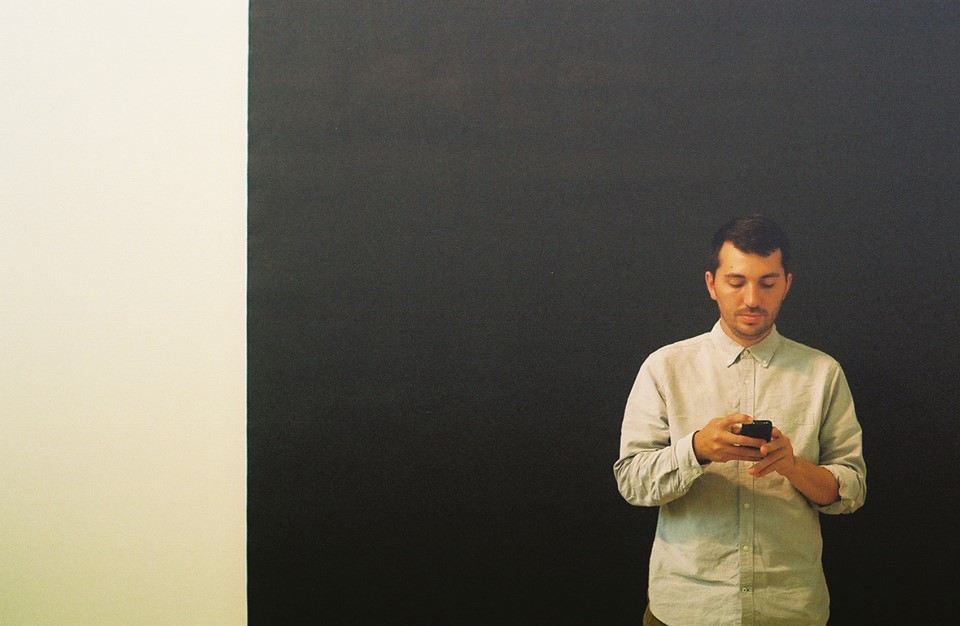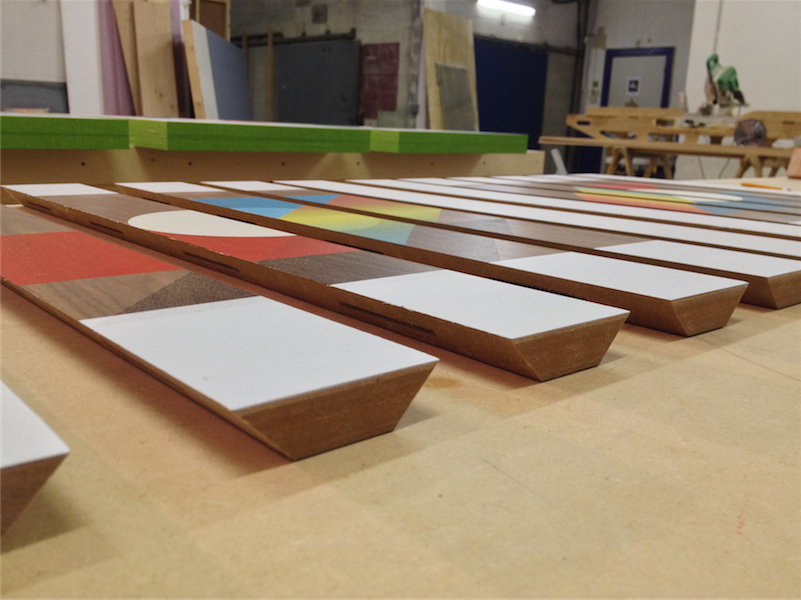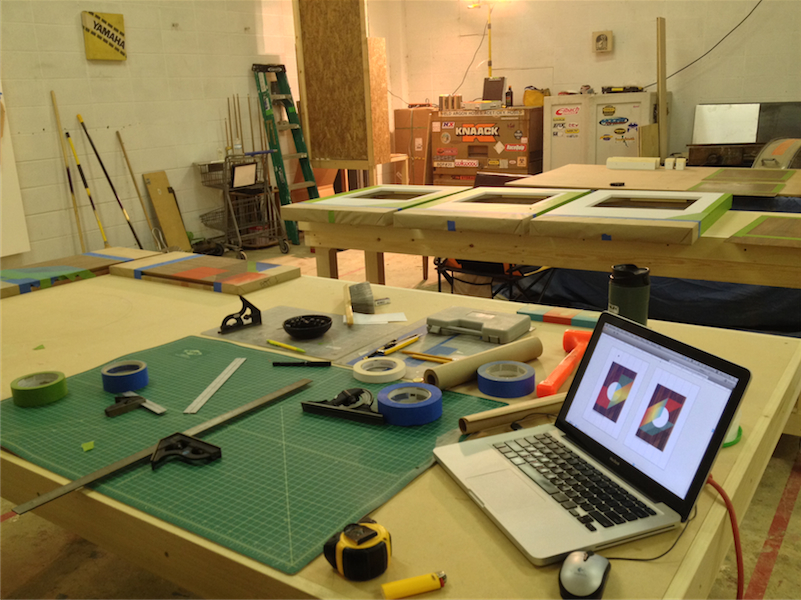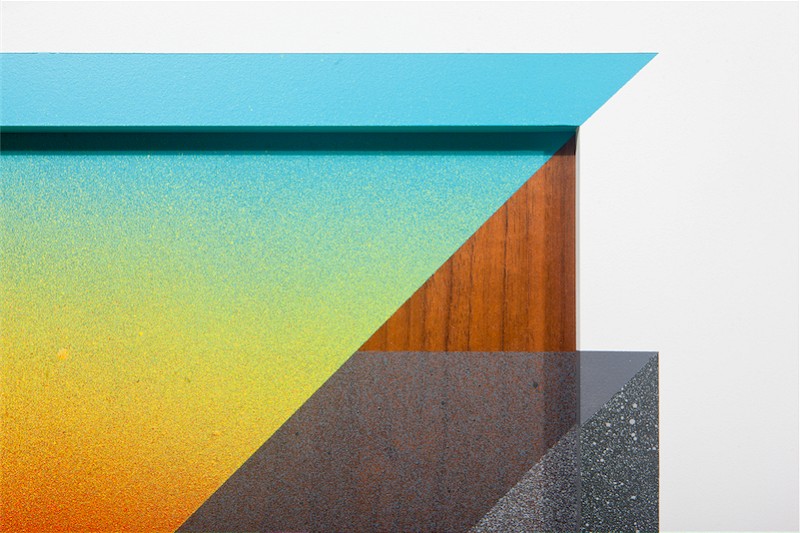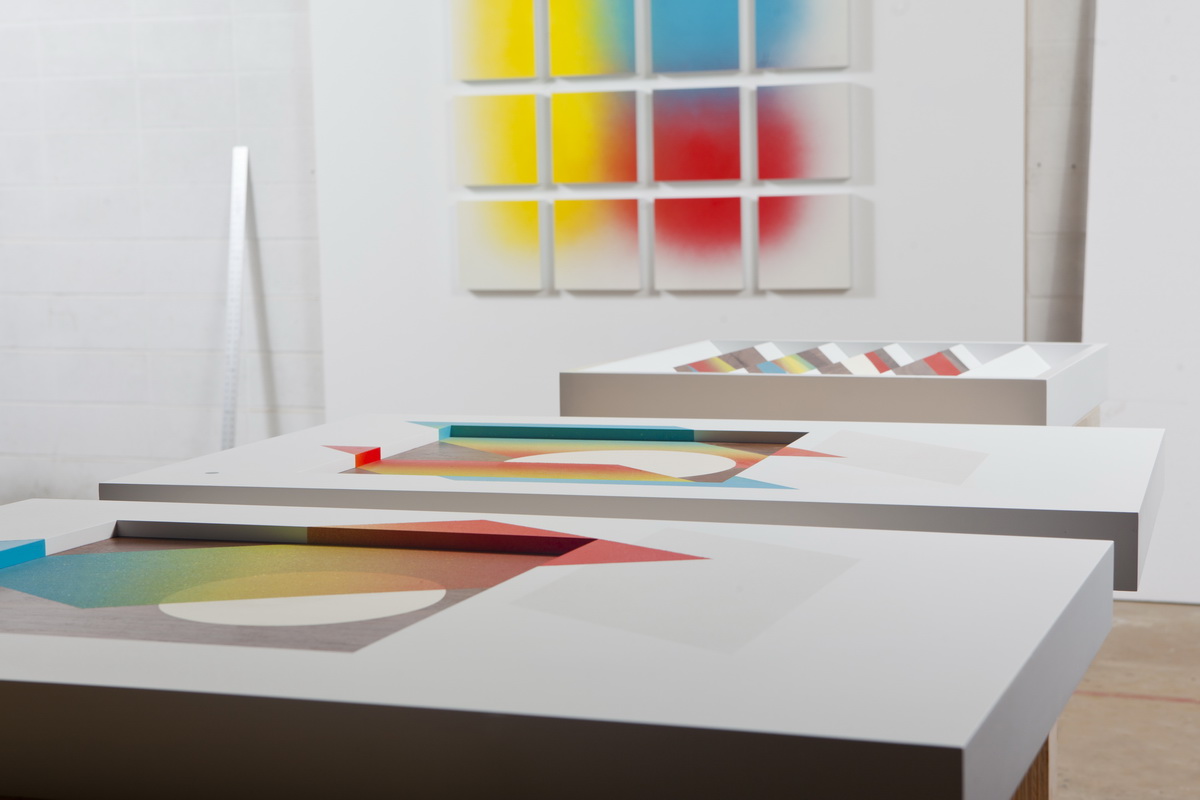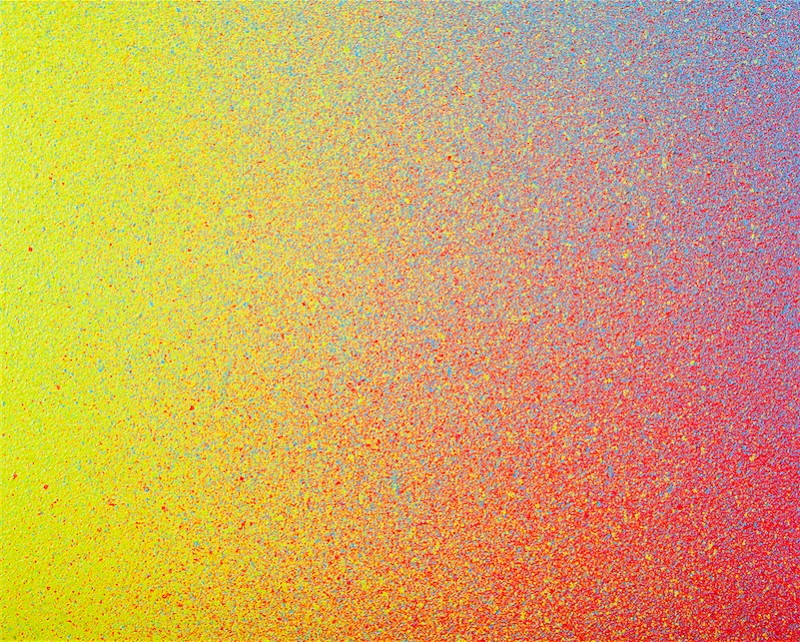Ever since he came back from his summer travels around Europe, where he was collaborating with other artists and collectives, American artist Christopher Derek Bruno has been back in his studio working on a new body of work for the upcoming three man show, Three The Hard Way, with Augustine Kofie and Jerry ‘Joker’ Inscoe at Breeze Block Gallery in Portland, Oregon opening on November 7th. Bruno, who made his mark by creating works that mix art and craftsmanship, design and optical illusions, kindly let us have a look inside of his studio in Atlanta, and see the parts of the works he is creating for the exhibition. Being a true creative perfectionist, with more ideas and concepts than time or resources to make those into reality, the young artist has created a diverse, time consuming process for creating his work. From rough sketches, to precise calculations, choice of right materials and tools, to actual preparing of raw material, and eventually painting and assembly, his creations are driven by urge to materialize his mind bending concepts. Playing with perspective and basic, familiar shapes, he is on a never-ending quest to find another way to question the way our eyes see the reality. By mixing basic color palette, with clean, geometrical lines, and his fine carpenter skills, while strongly depending on depth, dimension and point of view in his work, the resultant artwork is hard to be fully appreciated on flat photographs. That is why we asked him to tell us more about his work, his visions and plans, and show us around his studio/workshop.
Arrested Motion (AM): For those that aren’t familiar with your work, can you start off by giving us a little about your background?
Christopher Derek Bruno (CDB): I was raised in Atlanta, GA and started fooling around with graff in late ’96 when an older friend (who was my ride) stopped skating to paint under bridges and on freights. I have been studying and working as an industrial designer since ’03. Having always enjoyed the act of making and the challenges of problem solving, it has served as a really good base for a lot of exploration. I started to really be interested in the synthesis of technology and craft in school, as well as the concepts of design, and the interdependent relationship between object and user (or in art, the viewer).
My career path lead me to jobs in Portland, then Brooklyn where I was designing sustainable furniture until the economical crash of ’08 that decimated the industry. After that came a move to Seattle, where a good friend had a shop in place. I started back into the building industry by making objects for residential and commercial spaces, using any time between jobs to prototype designs. I also started getting into the fabrication of non-function based objects as a reaction to the unbalanced and unstable market that is furniture in the US.
I never stopped painting (graff), mostly on freights with close friends. It wasn’t until I was asked to show at Flatcolor Gallery in Seattle that I considered putting any weight on the merit of my non-functional designs/objects. Since then, I have continued to follow most all opportunities to create.
AM: How long were you writing graffiti for? Did you used to write ‘traditionally’ or have you always been into more mural-based work?
CDB: From ’96- ’03 I was really impressionable with graff, always partial to ‘euro’ styles more than traditional wild styles. It’s strange to be showing with Jerry ‘Joker’ Inscoe. I remember waiting for hours as my 56k modem would load images of the work he was putting out in Europe and having my mind blown.
I started really getting into freights when I saw my first Onorok panel. Atlanta’s history is deeply rooted in freight traffic, most all of the walls here are freight bridges. I still think freights are the best place to experiment and has the strongest and most authentic elements of graff culture. I still go out with a couple of friends and catch panels… not as often as I should though.
As for murals, they are more just an opportunity to push my technical abilities and approach to the picture plane. I enjoy most all chances I get to work in such a large scale using materials and techniques that are outside of my day to day in the shop. I wouldn’t necessarily lump graff into the mural work. I have always painted freights for fun, the mural stuff is an extension of a different aesthetic and conceptual train of thought and comes with a completely different audience…
AM: You’re a member of the Transcend Collective. How did you first come across those guys and what led to your joining?
CDB: Joker was my only real link to Transcend. He was always a hero/model of success. We met in Seattle where we were both showing work for a letter based show. I professed my respect, and began picking his brain about the alien world that was art. Since then, I owe most all of my exposure and opportunities to him. I was asked to be a part of Transcend in London, by Jerry and Kofie.
AM: You studied Industrial Design and this led to your use of manufactured materials within your artworks. I presume that this was a natural progression for you to incorporate the process of fabrication within your artworks?
CDB: It was definitely ‘A’ progression, but it didn’t come naturally. I was convinced for the longest time that it was important to keep all aspects of my life separate (like Costanzas theory of worlds colliding on Seinfeld). Graffiti was on trains and walls, with spray paint. Furniture was with wood, in the shop. Painting was oils on canvas. There were very strong barriers set in place to defend the sanctity of each discipline… kind of a creative schizophrenic, as each discipline had their own peer groups and sketchbooks that also had to be kept separate.
It wasn’t until almost everything around me had dissolved before I even considered the fact that all of the venues were coming from the same root and desire to make. Since this realization, it has been a conscious effort to distill every discipline to its core and use the combinations of my entire knowledge base to generate new work. It is still early in this concept for me. Everything so far has been a study in mixing concepts/techniques and paradigms of industrial design, fine art and the graff stuff.
AM: How did you enter into the world of anamorphic compositions? I’ve always been fascinated with your site-specific outdoor perspective work. It reminds me a little of Felice Varini. Care to reveal a little about how one of these pieces comes together?
CDB: All of the anamorphic works have all been temporary. They were the first experiments in combining design thinking, user experience, and graphic design. They follow the same process as most all of the works: I document the site, make digital mock-ups to scale, go back to the site with tools and install. There are several ways to place the composition onto the desired planes, it usually starts with a distorted grid and a bunch of math for me. When my friend Trey and I made the first one in the Summer of 2009, it was the best solution to engage the thousands of people that would be walking by an empty lot using the same street or viewing plane. We wanted to make something large and were asked by the event organizers to make something that would represent the 2-day event as a whole, our budget was tight so we used 2 miles of blue painters tape…. I think the 30lb. tape ball is still in his shop.
AM: Your work takes on many different forms and you must have a complex build up of ‘tools of the trade’. What’s your studio environment like?
CDB: I try to keep it efficient. I feel most comfortable working in a wood shop, so my studio set up most resembles that (maybe a little more white on the walls). Most all of my tools are for commercial woodworking and are used for my day job. I have a parts table, an assembly table and a large wall that I can use to work on larger pieces. Bins of paint and a self healing cutting mat are really the only equipment that are only used on the non-functional works. I have and will continue to use CNC technologies to manufacture parts when I can, and hopefully soon I can compile all of my work into a single space. I am still in the process of setting up my current studio and getting settled back in Atlanta… I have high hopes for the new space.
AM: Symmetry, alignment and form are important characteristics within your work. I especially enjoy some of the sculptural works you’ve created with Drew Tyndell and Ben Niznik. What aspect of your work gives you the most satisfaction?
CDB: Testing out new concepts is always intense, uneasy and a little stressful… if you are always questioning everything and every reason… it gets tough…. so the payoff when they come out looking good leads to a pretty solid feeling. Sustained periods of being “in it”, creatively or otherwise. Studio time is also pretty nice, you have the intent filled opportunity to be present.
As for DT and Ben, I really enjoy the act of working with those guys. I cannot express the level of respect I have for those two. We all come from different design backgrounds, so we all speak similar languages but bring different strengths to the collaborative table. It’s always fun and open. For the past 5 years we have all met up in Atlanta after Christmas to paint trains and make weird stuff. I hope it’s something we do for years to come.
AM: You took a sabbatical this summer and went traveling throughout Europe. The trip seemingly produced some interesting collaboration opportunities along the way with the likes of Moneyless, Clemens Behr and Graphic Surgery. What were the stand-outs of the trip for you?
CDB: The EU housed a set of massively influential set of experiences for me. Everyday was an eye-widening lesson in culture, language, and collaboration. The Italians were amazing to be around. The time shared, and conversations had with Teo (Moneyless) and Martina Merlini are still making me think in new ways today. I really enjoyed the difference in working on a wall in Testaccio, Rome and then in the forests near Lucca. In Amsterdam, I got the chance to spend a bunch of time in the Graphic Surgery studio which is an amazing place to work… I am always really excited to work in new spaces. After that it was to Berlin with Clemens, where I had the privilege of spending nearly two weeks biking around the city and working in studio. Working with Clemens and Raby was both incredibly fun and challenging in ways I am still coming to understand. I really enjoyed the work we produced and had a ton of fun hanging out with the guys from FortyFour Flavours.
In truth, I was spent a majority of my six weeks in the EU completely overwhelmed by genuine people and massive creative talent. I think if there had to be one take-away it would have to be the perspectives, education, and hospitality that was graciously shared by everyone encountered while traveling and working.
AM: The statement on your website explains that you seek to ‘explore the cognitive visual experience using a set of 0-dimensional points bound by 1-dimensional lines, combined to make 2-d planes, organized into 3-d forms, applied to objects with the express purpose of creating a 4-dimensional relationship with someone else’. In your experience, what kind of 4-dimensional relationships have you built? I’m interested in hearing stories of how people have reacted to the work.
CDB: It is a hope to think that there is some form of time based relationship with everyone that has interacted with the work. It’s hard to gauge exactly what level of impact those relationships have had. Making work has opened up the opportunity for trips like this summers in the EU, where people were excited and interested in collaboration. Part of the concept statement aims to address the universal rule set that we all participate within. One of the work’s goals is to address the relationship between viewer and object, hopefully generating some form of question and then falling away. I hope the work is at the very least visually interesting to someone, or at least interesting enough to require a pause or break in step.
AM: The next big project is a three person exhibition this November with Jerry Inscoe and Augustine Kofie. Care to tell us a little about what you have planned for the show? Are you looking forward to working with Joker and Kofie?
CDB: Really honored and excited to be a part of this line-up. Kofie and Jerry are both so strong, it’s crazy to be included in a show with them.
As for the new works: This past year has been one of polarizing transitions for me. So much change and movement outside of the work itself has lead to a new set of questions and a completely new set of spaces in which to make things. The works for the upcoming show are kind of the first couple of hypotheses within my current state of mind/affairs. The materials and media will be consistent with previous works, we will see what the effect of the other variables produces.
AM: Thanks for you time Derek. Good luck with the exhibition!
CDB: Always, and thank you so much for the opportunity… It’s been fun.
Discuss Christopher Derek Bruno here.
Discuss this show here.



